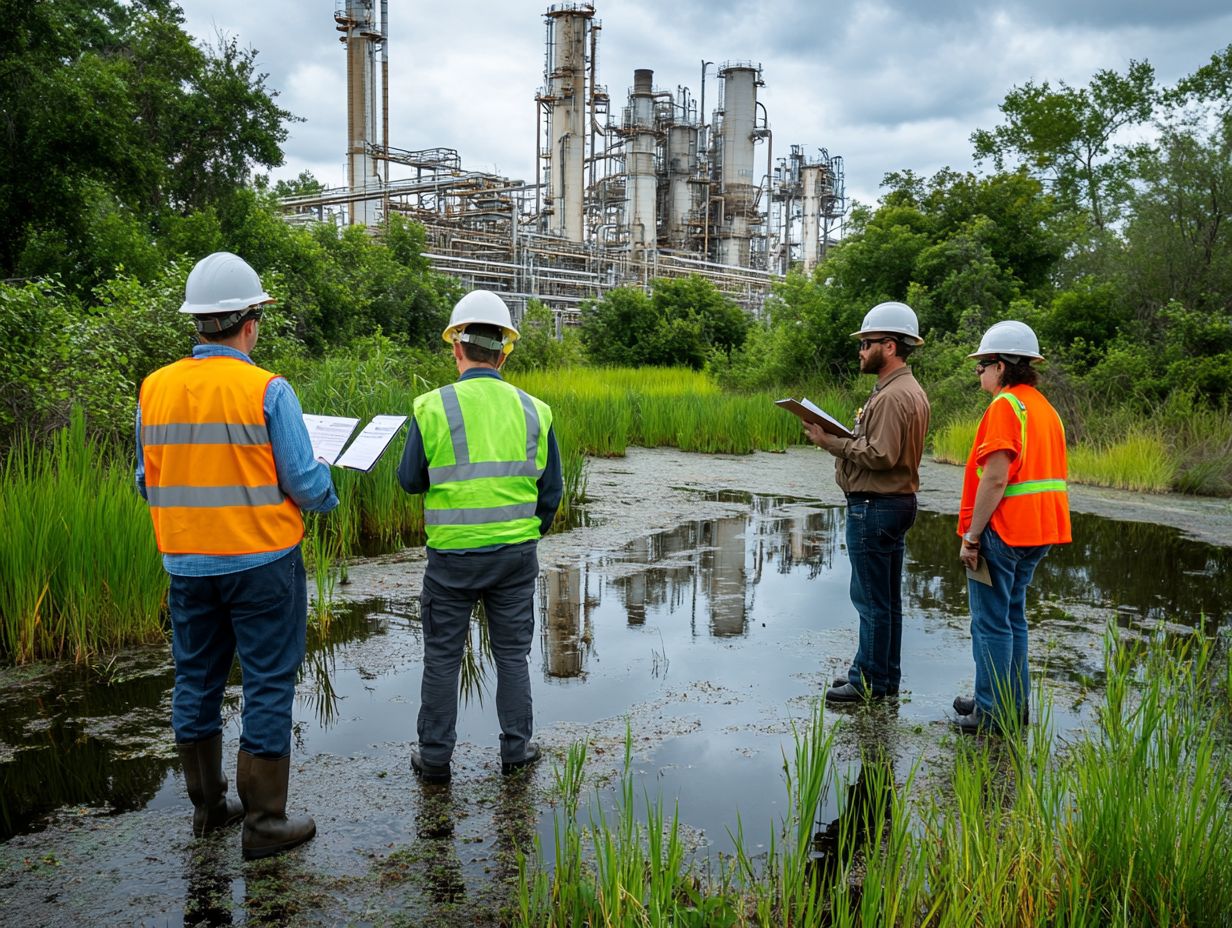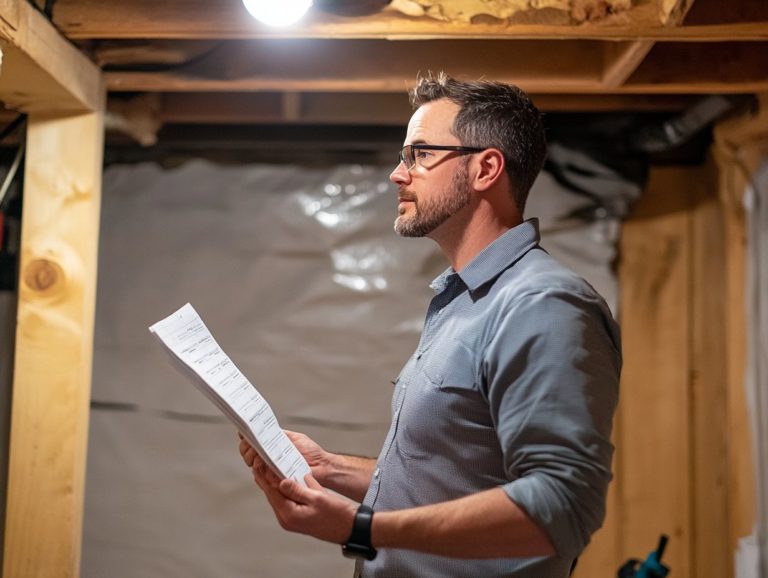Understanding Environmental Inspections
Environmental inspections are vital for protecting your health, property, and the planet. These assessments, whether for residential, commercial, or industrial properties, identify potential hazards and contaminants that could pose significant risks.
This article explores the different types of inspections. It highlights common issues they uncover and outlines the step-by-step process involved. Additionally, it emphasizes the benefits of these evaluations and provides guidance on selecting a qualified inspector.
Discover why these assessments are indispensable in today s world!
Contents
- Key Takeaways:
- What is an Environmental Inspection?
- Types of Environmental Inspections
- Common Contaminants and Hazards
- Environmental Inspection Process
- Benefits of Environmental Inspections
- Choosing a Qualified Inspector
- Frequently Asked Questions
- What is the purpose of understanding environmental inspections?
- What is included in an environmental inspection?
- Who conducts environmental inspections?
- How often should environmental inspections be conducted?
- What are the benefits of understanding environmental inspections?
- What happens if an environmental inspection reveals violations?
Key Takeaways:

Environmental inspections are essential for identifying potential hazards and contaminants that can affect human health and property. These inspections can be done for residential, commercial, and industrial properties. The process involves a thorough assessment and identification of any potential issues.
Hiring a qualified inspector is crucial for a thorough and accurate environmental inspection. Factors such as experience and certification should be considered.
What is an Environmental Inspection?
Environmental inspections are systematic processes designed to assess how well you adhere to environmental management standards and regulations. These inspections ensure compliance with environmental laws, protecting both public health and the environment.
Government agencies perform these checks to examine the environmental impact of your facility’s operations, identify any rule violations, and establish risk assessments that help mitigate potential environmental risks.
The data gathered during these inspections informs your environmental management strategies. This contributes to improvements in compliance monitoring practices, ultimately enhancing your overall environmental performance.
Purpose and Importance
The aim of environmental inspections is to ensure compliance with environmental management practices and regulations. This effectively minimizes your environmental impact while enhancing overall performance.
These inspections monitor compliance with established environmental standards. Doing so can significantly reduce the risks associated with not following the rules.
For instance, when a manufacturing facility routinely engages in environmental audits, it not only identifies potential hazards but also showcases its commitment to sustainability.
A case study of a prominent chemical plant revealed that regular inspections resulted in a remarkable 30% reduction in hazardous waste!
By proactively assessing risks, you can sidestep costly fines while enhancing your public image and building stakeholder trust. Act now! Proactively assess risks to avoid costly fines.
This ultimately leads to improved operational efficacy and a strong commitment to environmental stewardship.
Types of Environmental Inspections
Environmental inspections can be categorized into several distinct types, tailored to the specific nature of the facility and the regulatory requirements in place.
You will encounter facility inspections, environmental audits, and compliance assessments. These concentrate on key areas such as hazardous waste, air quality, and water quality.
Each type serves a unique purpose in ensuring that standards are met and environmental integrity is maintained.
Residential, Commercial, and Industrial
Residential, commercial, and industrial inspections each serve distinct purposes, expertly tailored to meet the unique environmental compliance needs of every type of facility.
Residential inspections primarily focus on safety, structural integrity, and potential hazards in homes. Critical issues such as lead paint and mold often come into play.
Commercial inspections dive deeper into ensuring that larger buildings follow the rules that keep people safe, evaluating essential factors like fire safety regulations and the integrity of electrical systems.
In contrast, industrial inspections deal with complex issues found in manufacturing plants and warehouses. Here, compliance with environmental regulations such as emissions standards and hazardous material storage is paramount.
Each setting presents specific challenges. For instance, aging infrastructure may be common in residential areas, while commercial sites often struggle to keep pace with evolving building codes. Industrial sites can face stringent waste management requirements.
Understanding these differences is crucial for anticipating environmental risks, such as soil contamination in industrial zones or air quality concerns in commercial spaces.
Common Contaminants and Hazards

Identifying and addressing common contaminants and hazards is essential for effective environmental inspections. These elements significantly shape environmental risks and impact the ecosystem.
By focusing on these factors, you can better mitigate risks and safeguard the environment.
Identifying and Addressing Potential Issues
It s crucial to identify and tackle potential issues during environmental inspections. This includes conducting a thorough risk assessment and adhering to established inspection protocols, both vital for effective compliance evaluation.
This process typically includes evaluating the physical landscape, analyzing emissions data, and reviewing operational practices that might pose risks to the environment.
You can use various tools, such as checklists and software applications, to capture detailed observations. Systematically documenting your findings and engaging in open dialogue with stakeholders helps uncover hidden challenges and vulnerabilities.
Tackling environmental concerns cultivates a culture of accountability and drives continuous improvement in environmental management practices. This approach ensures better compliance outcomes and fosters more sustainable operations moving forward.
Environmental Inspection Process
The environmental inspection process comprises a meticulous series of steps designed to ensure thoroughness and accuracy.
- Develop a comprehensive inspection plan tailored to your specific needs.
- Execute the inspection, gathering crucial data along the way.
- Compile an inspection report that outlines your findings and offers thoughtful recommendations for enhancing compliance.
This structured approach guarantees that no detail is overlooked!
Steps and Procedures
The process of conducting an environmental inspection involves several key steps:
- Pre-inspection planning
- Onsite evaluation
- Data collection
- Reporting findings using established performance indicators
During pre-inspection planning, gather background information about the site and its history. This knowledge helps identify potential environmental concerns effectively.
In the onsite evaluation, conduct a systematic examination of components such as air and water quality, waste management practices, and impacts on biodiversity.
As you collect data, document your findings with reliable tools and methodologies that align with compliance standards. The reporting stage synthesizes this collected data into actionable insights.
This transparent communication showcases areas that meet regulatory standards and highlights deficiencies requiring corrective measures, ultimately reinforcing your organization s commitment to environmental stewardship.
Benefits of Environmental Inspections
Environmental inspections offer a wealth of benefits. They elevate your environmental performance and ensure effective compliance monitoring.
Additionally, they help identify potential risks. This allows you to implement improved environmental management practices that significantly mitigate those challenges.
Protecting Health and Property

One primary benefit of environmental inspections is their ability to protect public health and property. They identify and mitigate environmental risks linked to hazardous waste and non-compliance with environmental standards.
These inspections are crucial for detecting toxic substances like lead and asbestos. Such substances pose serious health threats to communities.
Ensuring that businesses adhere to regulations regarding hazardous materials disposal helps prevent contamination of local water supplies and soil.
Regular assessments guarantee that industries follow best practices in waste management. This significantly reduces the chances of hazardous spills or accidents that could jeopardize employees and local ecosystems.
By prioritizing compliance with environmental guidelines, you contribute to creating safer, healthier environments for everyone involved.
Choosing a Qualified Inspector
Selecting a qualified inspector is essential for guarantees of comprehensive checks to ensure rules are followed and effective environmental audits.
This choice plays a pivotal role in the accuracy of inspection results and the overall integrity of the environmental inspection process.
Factors to Consider
- Qualifications
- Experience in environmental compliance
- Familiarity with regulatory standards
- Knowledge of relevant environmental management systems
Each of these elements is vital in determining the effectiveness of environmental inspections. A well-qualified inspector not only carries the necessary certifications but also possesses a deep understanding of current environmental laws and regulations.
Their experience in similar facilities can be invaluable. It helps uncover potential compliance challenges unique to your industry.
An inspector who grasps the intricacies of environmental management systems can pinpoint gaps and recommend improvements. This significantly enhances compliance.
Ultimately, this extensive expertise ensures thorough inspections, equipping your organization to meet or exceed legal requirements while fostering a culture of sustainability.
Frequently Asked Questions
What is the purpose of understanding environmental inspections?
Understanding environmental inspections is important. It helps individuals and organizations ensure compliance with environmental regulations, identify potential risks and hazards, and improve overall environmental performance.
What is included in an environmental inspection?

An environmental inspection typically includes a review of facility operations, waste management practices, potential sources of pollution, and overall environmental management systems.
It may also involve sampling and testing of air, water, or soil quality.
Who conducts environmental inspections?
Environmental inspections are conducted by trained professionals, such as environmental consultants, government agencies, or third-party organizations. These inspectors have the expertise and equipment to thoroughly assess environmental conditions.
How often should environmental inspections be conducted?
The frequency of environmental inspections varies depending on the facility type and potential environmental impact. Some industries are required to conduct regular inspections, while others may only need to do so once every few years.
What are the benefits of understanding environmental inspections?
Understanding environmental inspections helps prevent environmental hazards and risks. It improves regulatory compliance and protects public health and the environment.
It can also aid organizations in identifying areas for improvement and implementing more sustainable practices.
Want to learn more about how these inspections can save your business? Contact us today!
What happens if an environmental inspection reveals violations?
If an environmental inspection reveals violations, the facility may face fines, penalties, or legal action.
Organizations must act quickly to fix violations and prevent them from happening again. Don’t wait! Take action now!






